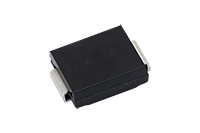 Vishay Intertechnology has introduced a new series of surface-mount TRANSZORB bidirectional, transient voltage suppressors (TVS) in the SMC (DO-214AB) package for automotive, industrial, and telecom applications.
Vishay Intertechnology has introduced a new series of surface-mount TRANSZORB bidirectional, transient voltage suppressors (TVS) in the SMC (DO-214AB) package for automotive, industrial, and telecom applications.
Offering a high-surge capability of 3 kW at 10/1000 μs to meet the specifications of ISO 16750-2 Pulse b, SMC3KxxxCAHM3_A series devices provide low leakage current down to 1 μA from 22 to 120 V and high-temperature operation to +175° C.
Suitable for high-reliability applications, the new Vishay General Semiconductor TVS are AEC-Q101 qualified and offer extremely stable breakdown voltage from 11.1 to 133 V across their entire operating temperature range of -55° to +175° C. Designed to protect sensitive electronic equipment against voltage transients induced by inductive load switching and lightning, the devices are intended for automotive load-dump protection and signal line protection in industrial and telecom systems.
The SMC3KxxxCAHM3_A series consists of 33 TVS part numbers with stand-off voltages from 10 to 120 V. The devices offer fast response times and a low incremental surge resistance, and excellent clamping capability with a maximum clamping voltage from 17.0 to 193 V at 10/1000 μs. The devices are RoHS-compliant and halogen-free and offer a moisture sensitivity level (MSL) of 1 in accordance with J-STD-020, LF maximum peak of 260° C.
Samples and production quantities of the new SMC3KxxxCAHM3_A series are available now, with lead times of 12 weeks for large orders.
Filed Under: Automotive, Components, News


Questions related to this article?
👉Ask and discuss on Electro-Tech-Online.com and EDAboard.com forums.
Tell Us What You Think!!
You must be logged in to post a comment.